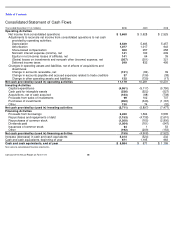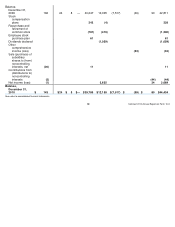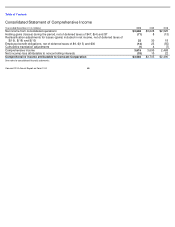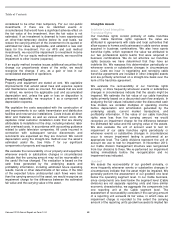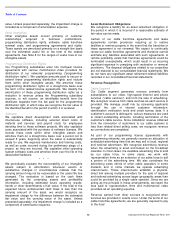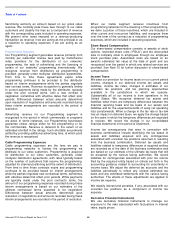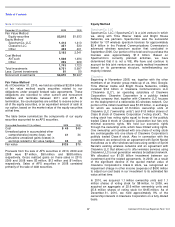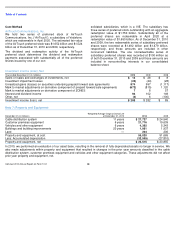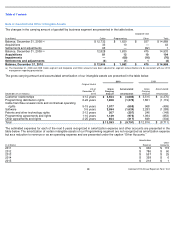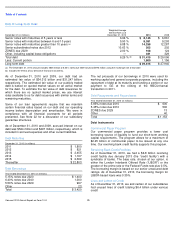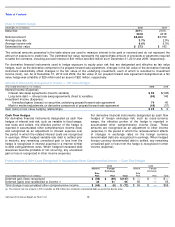Comcast 2010 Annual Report Download - page 74
Download and view the complete annual report
Please find page 74 of the 2010 Comcast annual report below. You can navigate through the pages in the report by either clicking on the pages listed below, or by using the keyword search tool below to find specific information within the annual report.
Table of Contents
65
Comcast 2010 Annual Report on Form 10-
K
and foreign currency exchange rates. Our objective is to
manage the financial and operational exposure arising from
these risks by offsetting gains and losses on the underlying
exposures with gains and losses on the derivatives used to
economically hedge them. Derivative financial instruments
are recorded in our consolidated balance sheet at fair value.
We formally document, at inception of the relationship,
derivative financial instruments designated to hedge the
exposure to changes in the fair value of a recognized asset
or liability or an unrecognized firm commitment (“fair value
hedge”) or the exposure to changes in cash flows of a
forecasted transaction (“cash flow hedge”), and evaluate
them for effectiveness at the time they are designated, as
well as throughout the hedging period.
For derivative financial instruments designated as fair value
hedges, changes in the fair value of the derivative financial
instrument substantially offset changes in the fair value of the
hedged item, each of which is recorded to the same line in
our consolidated statement of operations. When fair value
hedges are terminated, sold, exercised or have expired, any
gain or loss resulting from changes in the fair value of the
hedged item is deferred and recognized in earnings over the
remaining life of the hedged item. When the hedged item is
settled or sold, the unamortized adjustment in the carrying
amount of the hedged item is recognized in earnings. For
derivative financial instruments designated as cash flow
hedges, the effective portion of the change in fair value of the
derivative financial instrument is reported in accumulated
other comprehensive income (loss) and recognized as an
adjustment to earnings over the period in which the hedged
item affects earnings. When the hedged item is settled or
becomes probable of not occurring, any remaining unrealized
gain or loss from the hedge is recognized in earnings. Cash
flows from hedging activities are classified under the same
category as the cash flows from the hedged items in our
consolidated statement of cash flows. The ineffective portion
of changes in fair value for designated hedges is recognized
on a current basis in earnings.
For those derivative financial instruments that are not
designated as a hedge, changes in fair value are recognized
on a current basis in earnings. Derivative financial
instruments embedded in other contracts are separated from
their host contract. The derivative component is recorded at
its estimated fair value in our consolidated balance sheet and
changes in its fair value are recorded each period in
earnings.
We do not engage in any speculative or leveraged derivative
transactions. All derivative transactions must comply with the
derivatives policy approved by our Board of Directors.
See Note 10 for further discussion of our derivative financial
instruments.
Note 3: Recent Accounting Pronouncements
Consolidation of Variable Interest Entities
In June 2009, the Financial Accounting Standards Board
(“FASB”) updated the accounting guidance related to the
consolidation of VIEs. The updated guidance (i) requires an
ongoing reassessment of whether an enterprise is the
primary beneficiary of a VIE, (ii) changes the quantitative
approach previously required for determining the primary
beneficiary of a VIE and replaces it with a qualitative
approach, and (iii) requires additional disclosure about an
enterprise’s involvement in VIEs. We adopted the updated
guidance on January 1, 2010 and it did not impact our
consolidated financial statements.
Note 4: Earnings Per Share
Basic earnings per common share attributable to Comcast
Corporation shareholders (“basic EPS”) is computed by
dividing net income attributable to Comcast Corporation by
the weighted-average number of common shares outstanding
during the period.
Our potentially dilutive securities include potential common
shares related to our stock options and our RSUs. Diluted
earnings per common share attributable to Comcast
Corporation shareholders (“diluted EPS”) considers the
impact of potentially dilutive securities using the treasury
stock method. Diluted EPS excludes the impact of potential
common shares related to our stock options in periods in
which the option exercise price is greater than the average
market price of our Class A common stock or our Class A
Special common stock, as applicable.
Diluted EPS for 2010, 2009 and 2008 excludes
approximately 168 million, 195 million and 159 million,
respectively, of potential common shares related to our
share-based compensation plans, because the inclusion of
the potential common shares would have had an antidilutive
effect.



